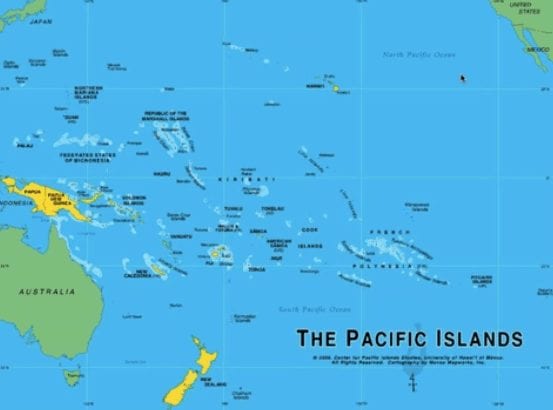

As we have noted on Reneweconomy before, Australia’s renewable energy target of 20 per cent by the year 2020 is Not The Most Ambitious In The World.
But sometimes it’s good to remind ourselves exactly where we stand in the global scheme of things. Some insight on this was offered this week via an International Solar Energy Society (ISES) webinar, looking at the huge shift to renewables being undertaken by some of our nearest neighbours, the Pacific Island nations.


As noted in the webinar by Geoff Stepleton, who is chair of ISES and one of the co-founders of Global Sustainable Energy Solutions, the rollout of renewables to the Pacific Islands is no easy task. There are 26 countries or territories spread across the Pacific Ocean that are considered part of the Pacific Island nations, many have no roads and are accessible only by boat.
“We’re talking about …an area as big as the whole world’s land mass, but with a population of just over 11 million people. …Take PNG out of the mix and you’ve got just over three million people over a very, very large area that are looking for services.”
This – and their position on the front line of climate change (think sea level rise and extreme weather) – means the Pacific Island nations have a keen understanding of the importance of renewables, both as a safer, cheaper and more reliable power source for their needs going forward and as a much cleaner electricity source than diesel fuel.
And perhaps that helps explain why there are so many that have far more ambitious renewable energy targets than Australia. Among the island nations listed in the tables below, we count nine with higher RETs than Australia – four of them 100 per cent and one 90 per cent. Two are equal to Australia’s, although considering one of those is being undertaken alongside a goal of 95 per cent electricity access (Republic of Marshall Islands) we are counting that as more ambitious than Australia.
Already, a lot has been happening in the region, some of it informed by the experiences of HydroTasmania at Australia’s own Flinders and King Islands. And below are some examples of what is currently being done by those Island nations shooting for 100 per cent – by 2020 for Cook Islands and Tonga, and by 2017 for Samoa. Meanwhile, in Australia…
New research identifies electorate of New England as the most valuable patch of land in…
United Firefighters Union of Australia says Dutton's nuclear power plan introduces a "new, more dangerous…
Greens to block federal approval of new coal and gas mines in a hung parliament,…
Swiss startup inaugurates first removable solar power plant on an operational railway line, and is…
No matter where you live, you have a vote that matters on climate at this…
Queensland researchers say they have set a new efficiency record for a type of solar…